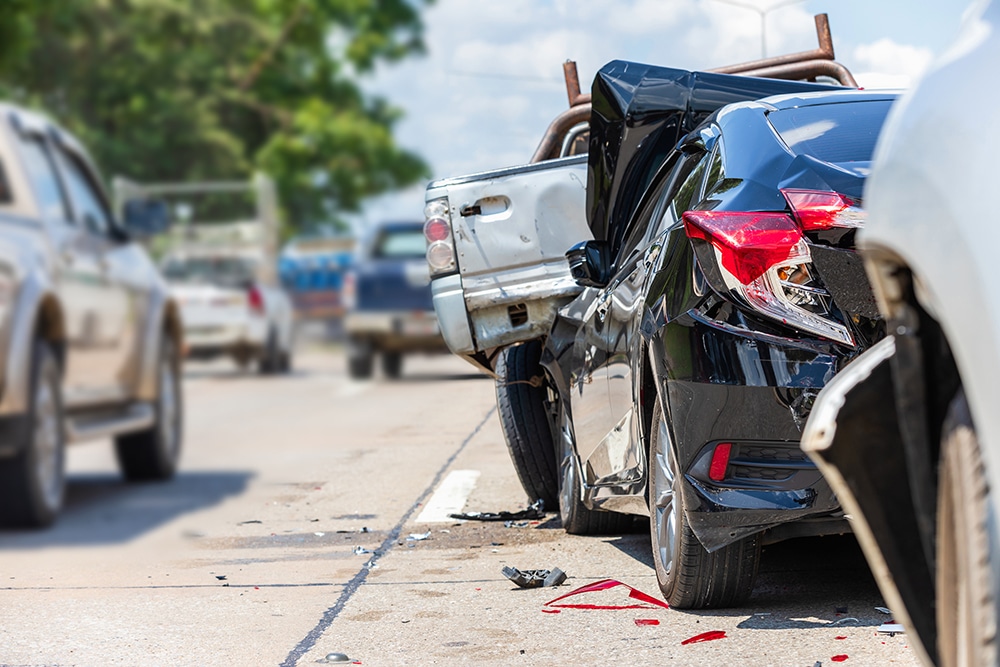As devastating as it can be to find yourself mired in a personal injury case, it could feel even more overwhelming when multiple parties are involved. This multiple-party status occurs when more than one person, or party, is found to be at fault for contributing to an accident.
These multiple-party cases tend to be more complex when you are seeking to recover damages from one party. It gets even more complicated when insurance companies, their lawyers, your personal injury lawyer, and the court have to determine how much each party is culpable for contributing to the injuries. In most cases like this, each party will be assigned a percentage of the fault for the damages you are seeking. From there, each party is held responsible for paying their part of the settlement or verdict if you win at trial.
Let’s look at an example of a multiple-party accident. For example, you are in an accident and it was found that there were three culpable parties. Party A was trying to beat a red light at an intersection. Party B attempted to turn left as the light was turning red. Party C was in a rush and entered the intersection right after the traffic light turned green.
As a result of this confluence of events, all three parties struck each other and slid out of control into the oncoming cross-traffic lane, where you were on your motorcycle. You didn’t have enough time to react because of the suddenness of these actions. All three cars ran into you during the crash.
Once you filed your personal injury claim with assistance from your lawyer, it is concluded that Party A is 50 percent at fault for the incident. Party B is 30 percent at fault, and Party C is 20 percent at fault. After haggling with the various insurance companies, it is determined that you are eligible to receive $500,000 in damages.
Party A and their insurance company are found responsible to pay $250,000. Party B and their insurance company must pay $150,000. Party C and their insurance company would be responsible for paying $100,000.
In a situation when one party is not able to pay their share of the damages, you may not be permitted to seek compensation from the other two parties. The reason for this is that courts may not hold the defendants jointly responsible for the damages.
How Fault is Determined in a Multiple-Party Personal Injury Claim
There must be an extensive review of the details and circumstances of an accident in order to determine how much each party is responsible for multi-party personal injury cases. Your attorney will need to examine copies of police reports, accident reports, witness statements, and each statement made by those involved in the incident.
It is common in multiple-party accidents for each person to have their own versions of what happened. You can count on the likelihood of no one admitting fault for the accident.
What usually happens is that each party will transfer the blame to another responsible party. For example, in this past cited accident, Party B – who turned left as the light was switching to red – could assert that they had the right-of-way and the accident was completely Party A’s fault. And Party C might attempt to shift blame claiming that if Party A and Party B did not try to beat the red light, the accident would not have occurred in the first place.
The insurance companies will behave similarly, assigning culpability onto the other parties to avoid paying any damages or to pay the least amount possible.
Determining Negligence in a Multiple-Party Personal Injury Claim
In order to ascertain how much each person’s negligence contributed to the accident, the law relies on two important principles:
- Contributory Negligence
- Comparative Negligence
Contributory Negligence
An accident falls into the contributory negligence category if when a person is determined to have contributed to their accident and personal injuries, they cannot pursue damages from other parties. The only method for recovering damages is if you were found to be 0 percent at fault.
This type of negligence is only used in several states, and Washington State is not one of them.
Comparative Negligence
Comparative negligence allows blame to be shared and damages to be awarded based on each individual’s share of the fault. Under comparative negligence, a defendant can raise a partial defense, saying that the plaintiff was partially at fault for the accident too.
Citing our previous accident example, Party A was found 40 percent at fault. Party B is still 30 percent at fault, and Party C is 20 percent at fault. You were found to be 10 percent at fault. Based on comparative negligence, each party will collect damages reduced by the percentage they were found to be at fault.
Modified Comparative Negligence
This is the most common approach to determining how damages will be allocated in a personal injury case. The plaintiff will not recover damages if they are found to be either equally responsible or more responsible for the injuries. In essence, in order to recover damages, the plaintiff must not be more than 50 percent at fault for the resulting injury.
Going back to our previous accident example, let’s assume Party A was 60 percent responsible, Party B was 20 percent responsible, and Party C was 20 percent responsible. You were 0 percent responsible.
Under modified comparative negligence, even though Party A’s damages were $100,000, they would not be able to collect anything because they were 60 percent at fault.
Party B’s $200,000 in damages would be reduced by 20 percent for a total of $160,000. Party A would have to pay $120,000, and Party C pays $40,000.
What’s more, Party C’s $300,000 in damages would also be reduced by 20 percent for a total of $240,000. Party A would pay $180,000 and Party B pays $60,000.
Each party is also responsible for paying their percentage of your $500,000 in damages. Rather than using a specific formula, the exact percentage of responsibility is determined during the settlement negotiation process among the insurance companies, their lawyers, and your personal injury lawyer.
Roberts Jones Law Is Here To Serve Your Legal Needs
If you have been involved in an accident and there are multiple parties involved, you need legal services from an experienced personal injury attorney from Roberts Jones Law. Our attorneys at Roberts Jones Law have the expertise and experience necessary to effectively handle multiple insurance companies simultaneously and to build a case designed to protect your rights and interests.
At Roberts Jones Law we will provide you with the guidance, care, and support needed to secure the compensation you deserve. If you have been injured as a result of someone’s carelessness, breach of duty of care, or deliberate act, you have rights under the law to seek compensation for your damages.
Trust the attorneys at Roberts Jones Law when you want legal services catered to your individual needs.
This article is for informational purposes only and does not contain legal advice.






